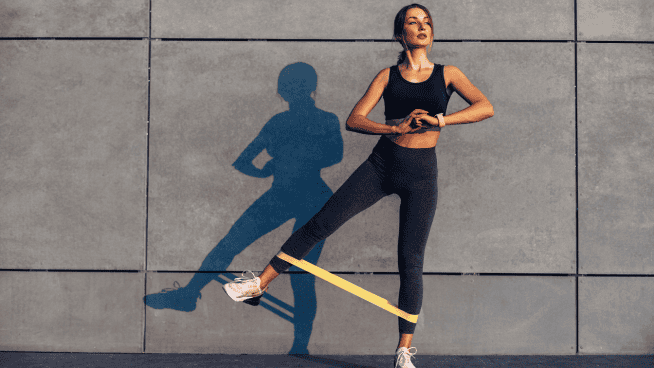From Workouts to Brain Mapping: A Behind-the-Scenes Look at How NBA Prospects Grind to Raise Their Draft Stock
“If you miss on the right player, that player is going to hurt you a couple times a year every time you play him. But if you draft the wrong player, he’s going to hurt you 365 days a year.”
That quote, passed on from an NBA general manager to basketball trainer Drew Hanlen, sums up the importance of the NBA Draft. There is immense pressure on NBA front offices, especially those sinking in the swamps of awfulness (e.g., Minnesota Timberwolves, New York Knicks) to take a player who will turn their franchise around. Prior to the draft, teams do everything possible to ensure the guy they’ve targeted won’t end up burning them, including bringing in a select few players for private workouts to poke, prod and observe everything they can.
Hanlen, who trained last year’s No. 1 overall pick Andrew Wiggins and works with guys like Bradley Beal, David Lee and Wiggins’ teammate Zach LaVine, understands better than most the chaotic two and a half months between the end of March Madness and the Draft. And he knows the three things NBA teams look for, the things that separate even the most talented of prospects from each other, the things that make the difference between a player going No. 1 overall and dropping down to 5 or 6.
RELATED: Watch Rakeem Christmas’s pre-Draft training session at Impact Basketball
What NBA Teams Look For
First and foremost is the player’s body of work. NBA scouts and coaches watch hundreds of hours of college and high school game tapes to learn how players perform in games.
“Body of work trumps everything else,” Hanlen said.
Next, teams look at a player’s physical attributes and fitness level to assess his potential to become an impressive physical specimen. Has he slacked off during the off-season and put on a few pounds? Or has he been getting after it like he would in-season?
“Are they able to compete with NBA athletes? Are they quick? Do they jump high? Are they long?” Hanlen said of the questions floating around an NBA team’s braintrust. “They want to see if they have the raw capability of becoming an NBA player and lasting in the NBA for a while.”
Finally, teams want to see what improvements the player has made since the end of his college career. All NBA prospects are raw in one area or another. Their handles aren’t great yet. Their jumper needs work. Their defense has to improve. Teams hone in on these weaknesses, things that could burn them down the road, and they are curious to know whether the player has recognized them himself and put in the necessary work to start curing them.
“If [players] can’t shoot, then have they made changes, and how is it looking?” Hanlen said. “Is it looking like they are eventually going to be able to shoot? The NBA is a shot-making league; if you make shots you win games.”

To impress NBA teams, Texas’s Myles Turner has been working on fixing the way he runs.
Joe Abunassar, founder of Impact Basketball, has spent time working with 2015 draft prospects Myles Turner and Jarell Martin. Abunassar stresses the importance of fundamentals, which can be lost in college when coaches don’t have time to devote to basic basketball skills, like being balanced when you shoot. He also receives information from teams on the pros and cons of each player he’s training.
“We have clear feedback from teams as to what teams like about them and don’t like about them,” Abunassar said. “Our job is to correct the deficiencies and accentuate the positives. With Myles Turner, a big concern with him is people don’t like the way he runs. We’ve had him with a track coach every day. He does an hour and 15 minutes per day of glute and core activation. So we have different goals for each guy.”
RELATED: See how Texas big man Myles Turner improves his running mechanics prior to the NBA Draft

Andrew Wiggins, who is trained by Drew Hanlen, was the 2014-2015 NBA Rookie of the Year
Hanlen refers to his pre-draft time with Wiggins as an example of how improving, and even adding, a skill to the former Kansas Jayhawk’s game leading up the Draft ensured he’d be selected No. 1 overall. Wiggins had an inconsistent freshman year at Kansas, flashing the ability to score 20 or 30 points one night, then tallying just 10 or 11 the next. NBA teams were unsure if he’d be able to carry a team with his offense and become a coveted franchise player.
“With Wiggins last year, teams wanted to know, ‘Can he become a scorer?'” Hanlen said. “So we had to show them that we actually added a whole mid-post game to his repertoire. Andrew had the raw tools; he had a little bit of a body of work, but most people last year in the Draft were saying, ‘Well, he’s a good long-term prospect, but Jabari Parker is going to be better.’ Jabari got hurt, and Andrew averaged 17 points a game and kind of surprised people. It’s because he was able to make that growth.”
Knowing exactly what teams are looking for, Hanlen crafts a plan of attack for each of his players prior to the Draft.
RELATED: Former Penn State guard D.J. Newbill works hard as NBA Draft approaches
The Plan of Attack
As soon as he knows he’ll be working with a player, Hanlen, who is a big believer in sports science and analytics, watches every single possession of an athlete’s college career (and high school, for the one-and-dones with limited college tape).
“I’ll watch as much tape as possible so I know his game just as well, if not better, than he does,” Hanlen said.
Hanlen then crafts a plan based on the strengths and weaknesses he has observed through all those hours of analyzing game tape. He identifies three major points of emphasis to work on in depth with each player, plus two other areas that, time permitting, they will address on a more surface level.
“We’re going to work on [those things] until we master [them],” he said.
Next, Hanlen sits down with his trainee, goes over the game tape and presents his plan. He said, “In player development, trust is the most important thing. Most of these guys, they only have two or three months to prepare for the Draft. You have to get their trust right away.”
Hanlen earns that trust through proof. He mentions Kelly Oubre Jr., the University of Kansas guard he trained over the past few months in advance of the Draft.

Kelly Oubre Jr. is projected to go in the top 20 of the 2015 NBA Draft
“Oubre’s shot had a bunch of mechanical issues I wanted to change,” Hanlen said. “I charted all of his makes and misses when he was on-balance versus when he was off-balance, and there was a big difference in those numbers. He realized he actually shot about 25- to 30-percent better when he was on-balance versus off-balance. Right there, that was an easy stat that was proof to get him to buy in. Most of the time it’s not a battle, because these guys are eager to make it happen. Proof via video and analytics is the key to getting guys to buy in.”
Once a player has signed on to Hanlen’s plan, it’s time to get to work. Hanlen puts his athletes through two workouts a day, one focused on skill work and the other on making the types of shots they’ll be taking in game situations, correcting their shooting mechanics in the process.
“Every workout is filmed so we can go over film after their workout,” Hanlen said. “We’ll obviously then make adjustments on court.”
Abunassar likes to put his guys through drills that reflect what teams will do in their private workouts. Many teams invite several guys in to work out at the same time, and the players often participate in games of three-on-three.
“We try to run the morning sessions at a very fast pace. When these guys go in to work out for an NBA team, the pace is fast,” Abunassar said. “You have the GM sitting there watching you, and the head coach, so you’re not going to dog it. So we’re trying to get them used to going at a high level.”
Post-workout, it’s time for recovery. The athletes hop in a cryochamber, stretch, get massages and participate in yoga. But the most fascinating part of the off-court preparation Hanlen’s athletes partake in is something he calls brain mapping.
With a four-pronged machine atop their heads, prospects like Oubre and Oregon’s Joseph Young take a series of tests on an iPad. The machine monitors their brain activity in different states: frustration, calmness, stress, patience, or experiencing some other emotion. This provides insight into how a player will react to a given situation on the basketball court. It’s eerily futuristic.

Oregon’s Joseph Young has participated in brain mapping as part of his pre-NBA Draft training.
Hanlen said, “A guy like Joe Young is really quick on the court and sometimes we need him to slow down. When we did his brain map, we realized he was less concerned about getting the right answer on all the tests, but more concerned about finishing quickly. Guys like Kelly Oubre, who is very calm, he was really good on accuracy but we also noted that he was at his own pace and relaxed. These brain maps really help us identify how these guys work.”
The Game Changer
Even if a player passes all the tests, another factor plays in to a GM’s or a head coach’s thinking—a wildcard if you will. And that’s the player’s personality.
“The overall cloud over everything is: How are they as a person, as a worker and how are they going to be in locker room?” Hanlen said. “You see Willie Cauley-Stein dropping a lot right now, because he has off-the-court character issues that are questionable.”
Preparing guys to interview with several teams in a week and revealing their character and personality is also a big emphasis for Abunassar. He said, “After the Combine, our guys, like Rakeem Christmas, he’ll be on a rock star tour. He’ll go from one city to the next performing for these guys. We have to get them prepared for that grind, which is why we push them a little harder here.”
The wrong player will hurt you 365 days a year.
That’s why Hanlen and Abunussar do what they do, not only to make their athletes immensely better and improve their draft stock, but to get a sense of who they are. If they aren’t willing to put in the work, or they won’t be a positive presence in the locker room, it will show on draft night.
Just reading about the work these NBA prospects put in can be exhausting, but every minute of it is necessary. In a league where a new guy comes in every year to take your spot and your playing time, giving teams a glimpse into your work ethic and ability at such an early stage is critically important.
Hanlen has watched it pay off. He said, “Every guy that I’ve worked with over the past four years has had his stock rise from where it’s started, which is awesome.”
RECOMMENDED FOR YOU
MOST POPULAR
From Workouts to Brain Mapping: A Behind-the-Scenes Look at How NBA Prospects Grind to Raise Their Draft Stock
“If you miss on the right player, that player is going to hurt you a couple times a year every time you play him. But if you draft the wrong player, he’s going to hurt you 365 days a year.”
That quote, passed on from an NBA general manager to basketball trainer Drew Hanlen, sums up the importance of the NBA Draft. There is immense pressure on NBA front offices, especially those sinking in the swamps of awfulness (e.g., Minnesota Timberwolves, New York Knicks) to take a player who will turn their franchise around. Prior to the draft, teams do everything possible to ensure the guy they’ve targeted won’t end up burning them, including bringing in a select few players for private workouts to poke, prod and observe everything they can.
Hanlen, who trained last year’s No. 1 overall pick Andrew Wiggins and works with guys like Bradley Beal, David Lee and Wiggins’ teammate Zach LaVine, understands better than most the chaotic two and a half months between the end of March Madness and the Draft. And he knows the three things NBA teams look for, the things that separate even the most talented of prospects from each other, the things that make the difference between a player going No. 1 overall and dropping down to 5 or 6.
RELATED: Watch Rakeem Christmas’s pre-Draft training session at Impact Basketball
What NBA Teams Look For
First and foremost is the player’s body of work. NBA scouts and coaches watch hundreds of hours of college and high school game tapes to learn how players perform in games.
“Body of work trumps everything else,” Hanlen said.
Next, teams look at a player’s physical attributes and fitness level to assess his potential to become an impressive physical specimen. Has he slacked off during the off-season and put on a few pounds? Or has he been getting after it like he would in-season?
“Are they able to compete with NBA athletes? Are they quick? Do they jump high? Are they long?” Hanlen said of the questions floating around an NBA team’s braintrust. “They want to see if they have the raw capability of becoming an NBA player and lasting in the NBA for a while.”
Finally, teams want to see what improvements the player has made since the end of his college career. All NBA prospects are raw in one area or another. Their handles aren’t great yet. Their jumper needs work. Their defense has to improve. Teams hone in on these weaknesses, things that could burn them down the road, and they are curious to know whether the player has recognized them himself and put in the necessary work to start curing them.
“If [players] can’t shoot, then have they made changes, and how is it looking?” Hanlen said. “Is it looking like they are eventually going to be able to shoot? The NBA is a shot-making league; if you make shots you win games.”

To impress NBA teams, Texas’s Myles Turner has been working on fixing the way he runs.
Joe Abunassar, founder of Impact Basketball, has spent time working with 2015 draft prospects Myles Turner and Jarell Martin. Abunassar stresses the importance of fundamentals, which can be lost in college when coaches don’t have time to devote to basic basketball skills, like being balanced when you shoot. He also receives information from teams on the pros and cons of each player he’s training.
“We have clear feedback from teams as to what teams like about them and don’t like about them,” Abunassar said. “Our job is to correct the deficiencies and accentuate the positives. With Myles Turner, a big concern with him is people don’t like the way he runs. We’ve had him with a track coach every day. He does an hour and 15 minutes per day of glute and core activation. So we have different goals for each guy.”
RELATED: See how Texas big man Myles Turner improves his running mechanics prior to the NBA Draft

Andrew Wiggins, who is trained by Drew Hanlen, was the 2014-2015 NBA Rookie of the Year
Hanlen refers to his pre-draft time with Wiggins as an example of how improving, and even adding, a skill to the former Kansas Jayhawk’s game leading up the Draft ensured he’d be selected No. 1 overall. Wiggins had an inconsistent freshman year at Kansas, flashing the ability to score 20 or 30 points one night, then tallying just 10 or 11 the next. NBA teams were unsure if he’d be able to carry a team with his offense and become a coveted franchise player.
“With Wiggins last year, teams wanted to know, ‘Can he become a scorer?'” Hanlen said. “So we had to show them that we actually added a whole mid-post game to his repertoire. Andrew had the raw tools; he had a little bit of a body of work, but most people last year in the Draft were saying, ‘Well, he’s a good long-term prospect, but Jabari Parker is going to be better.’ Jabari got hurt, and Andrew averaged 17 points a game and kind of surprised people. It’s because he was able to make that growth.”
Knowing exactly what teams are looking for, Hanlen crafts a plan of attack for each of his players prior to the Draft.
RELATED: Former Penn State guard D.J. Newbill works hard as NBA Draft approaches
The Plan of Attack
As soon as he knows he’ll be working with a player, Hanlen, who is a big believer in sports science and analytics, watches every single possession of an athlete’s college career (and high school, for the one-and-dones with limited college tape).
“I’ll watch as much tape as possible so I know his game just as well, if not better, than he does,” Hanlen said.
Hanlen then crafts a plan based on the strengths and weaknesses he has observed through all those hours of analyzing game tape. He identifies three major points of emphasis to work on in depth with each player, plus two other areas that, time permitting, they will address on a more surface level.
“We’re going to work on [those things] until we master [them],” he said.
Next, Hanlen sits down with his trainee, goes over the game tape and presents his plan. He said, “In player development, trust is the most important thing. Most of these guys, they only have two or three months to prepare for the Draft. You have to get their trust right away.”
Hanlen earns that trust through proof. He mentions Kelly Oubre Jr., the University of Kansas guard he trained over the past few months in advance of the Draft.

Kelly Oubre Jr. is projected to go in the top 20 of the 2015 NBA Draft
“Oubre’s shot had a bunch of mechanical issues I wanted to change,” Hanlen said. “I charted all of his makes and misses when he was on-balance versus when he was off-balance, and there was a big difference in those numbers. He realized he actually shot about 25- to 30-percent better when he was on-balance versus off-balance. Right there, that was an easy stat that was proof to get him to buy in. Most of the time it’s not a battle, because these guys are eager to make it happen. Proof via video and analytics is the key to getting guys to buy in.”
Once a player has signed on to Hanlen’s plan, it’s time to get to work. Hanlen puts his athletes through two workouts a day, one focused on skill work and the other on making the types of shots they’ll be taking in game situations, correcting their shooting mechanics in the process.
“Every workout is filmed so we can go over film after their workout,” Hanlen said. “We’ll obviously then make adjustments on court.”
Abunassar likes to put his guys through drills that reflect what teams will do in their private workouts. Many teams invite several guys in to work out at the same time, and the players often participate in games of three-on-three.
“We try to run the morning sessions at a very fast pace. When these guys go in to work out for an NBA team, the pace is fast,” Abunassar said. “You have the GM sitting there watching you, and the head coach, so you’re not going to dog it. So we’re trying to get them used to going at a high level.”
Post-workout, it’s time for recovery. The athletes hop in a cryochamber, stretch, get massages and participate in yoga. But the most fascinating part of the off-court preparation Hanlen’s athletes partake in is something he calls brain mapping.
With a four-pronged machine atop their heads, prospects like Oubre and Oregon’s Joseph Young take a series of tests on an iPad. The machine monitors their brain activity in different states: frustration, calmness, stress, patience, or experiencing some other emotion. This provides insight into how a player will react to a given situation on the basketball court. It’s eerily futuristic.

Oregon’s Joseph Young has participated in brain mapping as part of his pre-NBA Draft training.
Hanlen said, “A guy like Joe Young is really quick on the court and sometimes we need him to slow down. When we did his brain map, we realized he was less concerned about getting the right answer on all the tests, but more concerned about finishing quickly. Guys like Kelly Oubre, who is very calm, he was really good on accuracy but we also noted that he was at his own pace and relaxed. These brain maps really help us identify how these guys work.”
The Game Changer
Even if a player passes all the tests, another factor plays in to a GM’s or a head coach’s thinking—a wildcard if you will. And that’s the player’s personality.
“The overall cloud over everything is: How are they as a person, as a worker and how are they going to be in locker room?” Hanlen said. “You see Willie Cauley-Stein dropping a lot right now, because he has off-the-court character issues that are questionable.”
Preparing guys to interview with several teams in a week and revealing their character and personality is also a big emphasis for Abunassar. He said, “After the Combine, our guys, like Rakeem Christmas, he’ll be on a rock star tour. He’ll go from one city to the next performing for these guys. We have to get them prepared for that grind, which is why we push them a little harder here.”
The wrong player will hurt you 365 days a year.
That’s why Hanlen and Abunussar do what they do, not only to make their athletes immensely better and improve their draft stock, but to get a sense of who they are. If they aren’t willing to put in the work, or they won’t be a positive presence in the locker room, it will show on draft night.
Just reading about the work these NBA prospects put in can be exhausting, but every minute of it is necessary. In a league where a new guy comes in every year to take your spot and your playing time, giving teams a glimpse into your work ethic and ability at such an early stage is critically important.
Hanlen has watched it pay off. He said, “Every guy that I’ve worked with over the past four years has had his stock rise from where it’s started, which is awesome.”











